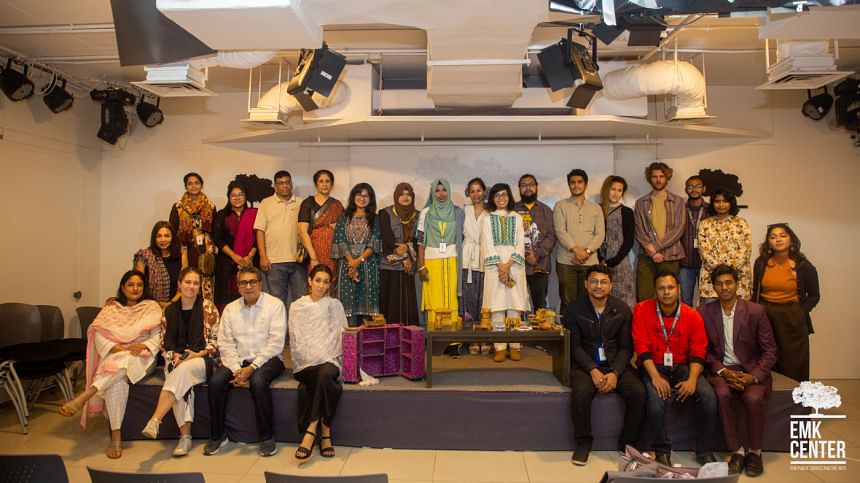Can Art make Peace: Stories from the Rohingya camps

On February 4, the US Embassy and EMK Center organised a cultural dialogue, "Can Art Make Peace?", featuring creative practitioners from the Rohingya camps—who shared stories and reflected on making art that showcases our shared humanity.
The discussion was part of a satellite event in the Dhaka Art Summit and was held in the Adda Room of the EMK Center premises.
By bringing together five art practitioners, who are working in the Rohingya camps, the panel discussion allowed them to share their diverse experiences. Throughout the session, the artists, storytellers, musicians, and craftspeople, discussed how such artistic collaborations might promote intercommunal understanding and aid in fostering peace.
The panellists included Tomal Hossain, a musician; Khwaja Fatmi, an architect; Rashad Wajahat, a filmmaker, and community teaching artists, Refa Akter and Beauty Akter. In an attempt to raise awareness about the ongoing Rohingya crisis, and to showcase Rohingya art, culture, music and stories, the conversations addressed the first-hand experience of being on the front lines of the largest refugee camp in the world.
The event kicked-off with the Embassy's Cultural Attache, Sharlina Hussain-Morgan delivering the opening remarks, followed by the presentation of photos and videos highlighting Artolution's work in the camps.
After her graduation from Bangladesh University of Engineering and Technology (BUET), Khwaja has worked with several non-profit organisations including NGO Forum, Oxfam, ActionAid, and IOM, engaging with communities across Bangladesh—from Dhaka to Jhenaidah, Ukhiya, Whykong, and Teknaf. Some of her notable projects include Healthy Neighborhood with Noapara Community, Display Center for Rohingya Women, and the Rohingya Cultural Memory Centre. She was recently recognised for her contributions in the Rohingya Response by the Aga Khan Trust for Culture. "Working at the camp has been a great learning experience for me, both personally and professionally. The first centre I worked on had to be temporary and I did not have much experience of working with bamboo as a material. The Rohingya locals helped me devise an optimum plan that saves the most material while ensuring strength and durability. Their ancestral home-building techniques, and community lessons led to a collaborative approach," she recalled.
Tomal, a PhD candidate in ethnomusicology at the University of Chicago, is presently working on research that concerns the musical life of several Rohingya refugee camps. He primarily intends to focus on the socio-political stakes of Rohingya tarana song performance and circulation. "Rohingya music has a wide variety of genres encompassing their vocals. While there is an evident lack of music literacy, their tarana songs are an excellent example of oral literacy," explained Tomal. "Music helped us understand one another despite our tones being so different. Creating art together felt more personal than simply talking to them about their lives. For us, Bollywood songs and Urdu ghazals were a direct way to connect and jam."
Rashad is a writer, photographer, filmmaker, and visual artist with a decade of storytelling experience in the Bangladeshi production industry. In the past couple of years, he has been working as part of the humanitarian response to the Rohingya refugee crisis in Cox's Bazar—amplifying stories from some of the most voiceless people in the world. "The interviews I took sometimes escalate beyond usual conversations as they feel triggered. Most of the stories we hear reinforce the stereotypes that already exist and we do not hear stories that tell us how talented these people are," he asserted.
Refa Akter, an accomplished community teaching artist from Ukhiya, has personal experience with the Rohingya influx. Her family were among the first to help the Rohingya migrants in 2017 when they arrived. For five years, she has been working with the Artolution team to create artwork with Rohingya children, and is in charge of the organisation's initiatives in ten camps. "Art can be anywhere, from paper to murals, all the way to plastic sacks in the camp. What we follow is a two-way process that allows the children to express themselves," she said.
Beauty Akter joined Artolution as a teaching artist in 2018, leading more than 40 community mural workshops with Rohingya women and girls within women-friendly-spaces. During the pandemic, she delivered public health messaging through community art in the camps and host communities. As a member of the Artolution team, she has created 100 community murals across 20 different camps. "Before working with this team, I had the notion that Rohingya are bad people. My experience has taught me a lot about how we should judge people based on the stereotypes we hear about them. They have been deprived of their identities and I am glad we could provide an outlet for them to express themselves," she explained.
During the discussion, the panellists also debunked some common stereotypes existing about the community. The panel's moderator, Shahirah, talked about her experiences of working at the camp. A writer and researcher by profession, she worked as a journalist at the Rohingya camp.
Shahirah showed a box of handicraft miniatures created by the Rohingya community. It contained a fishing net, boats carved on wood, stilt houses, machines and other examples of embroidery art. "The box is an attempt to preserve their cultural identities and can be taken from place to play by our cultural ambassadors. This helps other members of the community learn about their ancestral heritage while being miles away from the home," she concluded.

 For all latest news, follow The Daily Star's Google News channel.
For all latest news, follow The Daily Star's Google News channel. 






Comments